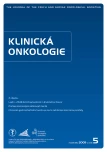Profiles of Low-Molecular Proteome Spectrum Obtained through SELDI-TOF Mass Spectrometry in the Sera of Patients with Metastatic Malignant Melanoma: Pilot Study
Authors:
R. Lakomý 1; K. Greplová 2; R. Pilný 2; E. Budinská 3; D. Valík 2; A. Poprach 1; R. Němeček 1; R. Vyzula 1
Authors‘ workplace:
Klinika komplexní onkologické péče, Masarykův onkologický ústav, Brno2 Oddělení laboratorní medicíny, Masarykův onkologický ústav, Brno3 Institut biostatistiky a analýz, Masarykova univerzita, Brno
1
Published in:
Klin Onkol 2009; 22(5): 228-232
Category:
Original Articles
Overview
Backgrounds:
Recently, research at genetic and molecular levels has extensively accelerated due to advances in new technologies. Since the mid-90s, a relatively new discipline – clinical proteomics, has evolved, which focuses on studying gene products – proteins. The evaluation of protein profiles may contribute to the more accurate stratification of patients in the future, in terms of both prediction of treatment results and prognosis. In pursuing this objective, proteomic approaches are currently used for the identification of new biomarkers. This is also the case with malignant melanoma, a disease without typical serum marker possessing high sensitivity and high specificity. Methods: We analyzed human blood serum samples from 25 patients with metastatic malignant melanoma treated with palliative chemotherapy at the Masaryk Memorial Cancer Institute, Brno, in 2004–2006. The analysis was performed by Surface Enhanced Laser Desorption/Ionisation Time of Flight Mass Spectrometry (SELDI-TOF-MS). Our patients were divided into two subgroups: a group relatively resistant to chemotherapy – 14 patients – and a group with certain clinical benefit from the treatment (complete and partial remission, stabilized disease) – 11 patients. We were searching for a new biomarker or typical protein profile in the selected two subgroups. Then, we recategorized our patients into three groups according to the similarity of their protein profiles regardless of sensitivity to chemotherapy. Finally, we evaluated differences in laboratory and clinical parameters, between both the groups of chemo resistant and chemo-sensitive patients, and newly defined subgroups with similar protein profiles. Conclusion: We did not identify any significant differences in protein profiles or laboratory parameters in the predefined chemo-sensitive or chemo resistant groups of patients. However, with regard to the new groups with similar protein profiles, we identified a subgroup of patients with different laboratory and clinical parameters. The results are very interesting and merit further research.
Key words:
proteomic – biomarkers – SELDI-TOF-MS
Sources
1. Pilný R, Michalová E, Brožková K et al. Příprava biologického materiálu pro metodu SELDI TOF MS. Brno: Edukační sborník XXXI. Brněnské onkologické dny 2007 : 360.
2. Wilson LL, Tran L, Morton DL. Detection of differentially expressed proteins in early stage melanoma patients using SELDI-TOF mass spectrometry. Ann NY Acad Sci 2004, 158 : 40–50.
3. Helanová S, Vyzula R, Žaloudík J et al. Technologie ciphergen – nová perspektiva v proteomice. Klinická onkologie 2004; 17 (5): 157–161.
4. Liotta LA, Petricoin EF. General keynote: proteomic patterns in sera serve as biomarkers of ovarian cancer. Gynecol Oncol 2003; 88(1Pt 2): S25–S28. Discussion S37–S42.
5. Mian S, Ugurel S, Parkinson E. Serum Proteomic Fingerprinting Discriminates Between Clinical Stages and Predicts Disease Progression in Melanoma Patients. J Clin Oncol 2005; 23 : 5088–5093.
6. Litvak A, Gupta R, Yee R. Endogenous Immune Response to Early and Intermediate-Stage Melanoma Is Correlated with Outcomes and Is Independent of Locoregional Relapse and Standard Prognostic Factors. J Am Coll Surg 2004; 198 : 27–35.
7. Ding Y, Prieto V, Zhang P. Nuclear Expression of the Antiapoptotic Protein Survivin in Malignant Melanoma. Cancer 2006; 106 : 1123–1129.
8. Geilen Ch, Georgieva J, Milling A. Malignant Melanoma – Markers for Progression and Prognosis in Malignant Melanoma, Front Radiat Ther Oncol. Basel: Karger 2006; 39 : 120–126.
9. Češková P, Brožková K, Hernychová L et al. Hmotnostní spektrometrie v kvantitativní a diagnostické proteomice: možnosti a limitace. Chem listy 2006; 100 (11): 974–979.
10. Brožková K, Knoflíčková D, Hernychová L et al. Identifikace potenciálních biomarkerů karcinomu prsu metodou SELDI-TOF-MS. Klin onkol 2007; 20(6): 377–383.
11. Pilny R, Bouchal P, Borilova S et al. Surface-Enhanced Laser Desorption Ionization/Time-of-Flight Mass Spectrometry Reveals Significant Artifacts in Serum Obtained from Clot Activator-Containing Collection Devices. Clin Chem 2006; 52(11): 2115–2116.
12. Dušek L, Mužík J, Kubásek M et al. Český národní webový portál epidemiologie nádorů [online]. Masarykova univerzita. Přístup z 2. 2. 2008. http://www.svod.cz. Verze 7.0.
13. Tusher VG, Tibshirani R et al. Significance analysis of microarrays applied to the ionizing radiation response. Proc NaH Aca Sci USA 2001; 98(9): 5116–5121.
Labels
Paediatric clinical oncology Surgery Clinical oncologyArticle was published in
Clinical Oncology

2009 Issue 5
Most read in this issue
- Rectal Neuroendocrine Tumours
- Chronic Gastrointestinal Toxicity after External-Beam Radiation Therapy for Prostate Cancer
- Evaporation of Selected Cytotoxic Drugs and Permeation of Protective Gloves – Research into the Occupational Risks of Health Care Personnel Handling Hazardous Cytotoxic Drugs (CYTO Project)
- Proteomic Analysis of Cancer Cells
